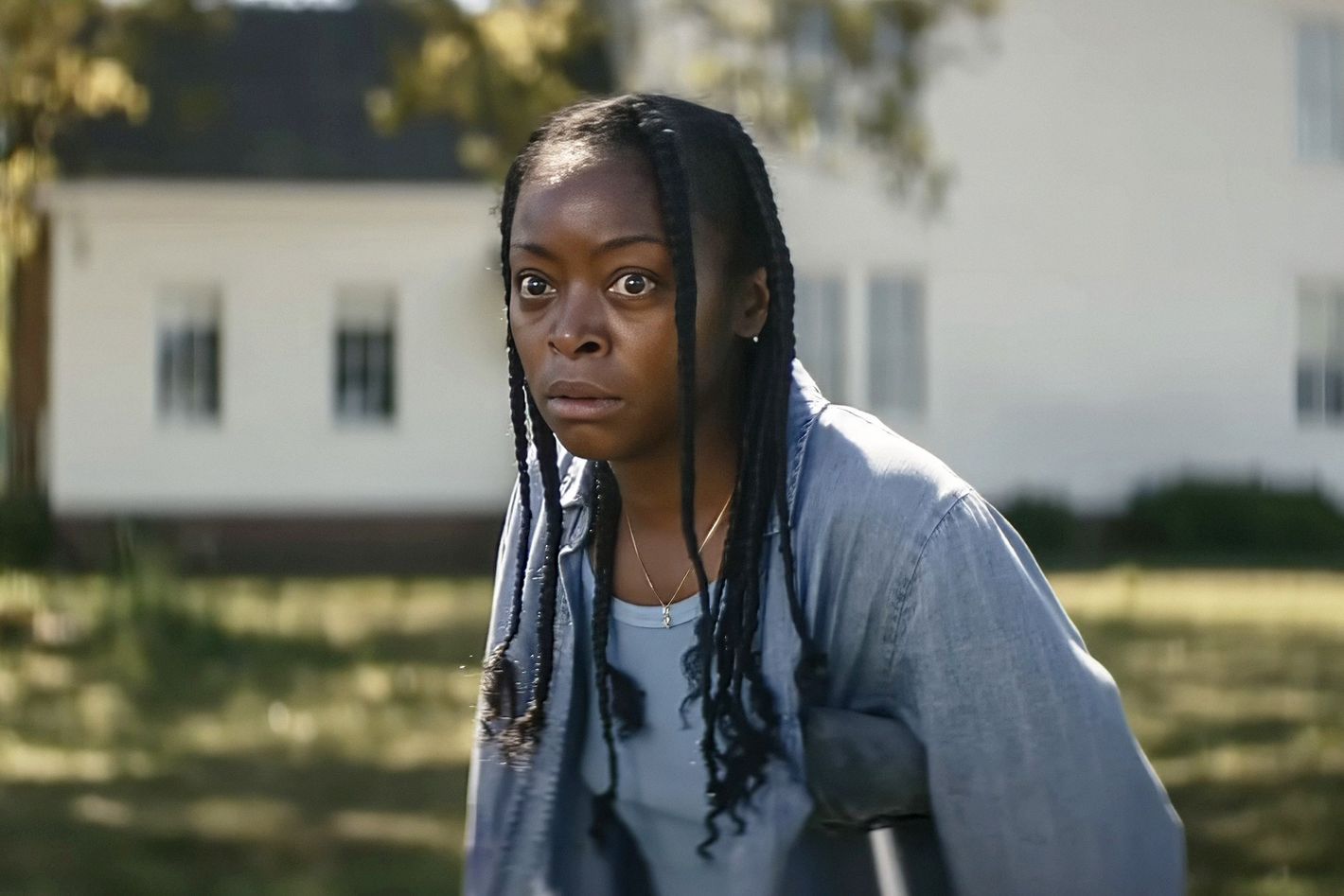The Twist in The Woman in the Yard Is a New Low for Trauma Horror


Spoilers ahead for the plot and ending of The Woman in the Yard.
There are two reasons why the meme of Jamie Lee Curtis saying “trauma” took off. First, because she said it funny — has the word ever been pronounced “trow-ma”? And second, because it captured a very real trend in contemporary horror, where the monster is a metaphor for our lead’s repressed emotions, buried grief, and, yes, trauma. This concept was not invented by Blumhouse’s 2018 Halloween, or by other 2010s heavyweights like The Babadook and Hereditary. You can find these kinds of metaphors in any number of earlier classics: Don’t Look Now, Carrie, and Rosemary’s Baby among them. But there’s no denying how firmly it’s taken hold over the last decade-plus, to the point that horror that’s really about trauma now feels more like the norm than the exception.
With that in mind, you can get a good sense of where The Woman in the Yard is going well before it arrives at its destination. The latest Blumhouse release centers on Ramona, played by Danielle Deadwyler, wading through grief over the death of her husband, David (Russell Hornsby), while recovering from the injuries sustained in the car crash that took his life. She’s now a single parent to two kids, Taylor (Peyton Jackson) and Annie (Estella Kahiha), and struggling to keep the lights on in their remote farmhouse. Her situation looks bleak enough before the titular Woman (Okwui Okpokwasili) arrives. Planted on a chair in the front yard and draped from head to toe in a black shroud, she claims to have been invited by Ramona. “Today’s the day,” the Woman tells her. “You called and I came.”
Ramona tries to assure her kids that there’s nothing out of the ordinary. Perhaps the Woman simply wandered off from the nearest nursing home, she offers. Her son wonders if the Woman might be dead and using the shroud to hide her hideous disfigurement. But a monster is never just a monster anymore, and those of us who are familiar with modern horror — and with the Blumhouse brand — can pretty easily jump to our own explanation. The Woman must be a manifestation of Ramona’s grief: a thing that arrived uninvited into this family’s life, cast a shadow over their home, and refused to leave.
As it turns out, she is and she isn’t. Over the course of The Woman in the Yard, it becomes clear that what Ramona is experiencing goes beyond normal grief (however normal grief can be). She has violent fantasies, including ones in which she stabs Annie with a butcher knife. She loses time and finds herself transported back to the moment of impact, the broken glass hovering in the air around her. This all could be trauma, but Taylor reveals that his mother is on “crazy pills,” suggesting something more diagnosable. Sure enough, the final act of the movie has Ramona switching places with the Woman, confirming they were always two parts of the same whole. “I’m the corners of your mind, the scary parts,” the Woman explains. She is Ramona’s depression, or, more pointedly, her suicidal ideation. Every morning, Ramona has been praying for strength — not so she can get her life back on track and take care of her kids, but so she can use David’s gun to take her own life. “Today’s the day,” she follows through: The Woman has arrived to help Ramona pull the trigger.
“It’s a grief metaphor” would have been predictable as a twist, but still preferable to what The Woman in the Yard gives us instead, a deeply troubling portrayal of mental illness that makes Ramona’s depression a violent monster. Deadwyler gives the kind of committed, lived-in performance we’ve come to expect from her, while director Jaume Collet-Serra manages some creative camerawork — all the more impressive given that the film largely takes place during the day, with the titular Woman sitting calmly on a chair. But the real talent involved doesn’t change the way the climactic scene lands, with Ramona and her shadow self jointly guiding the shotgun under her chin.
Depictions of suicide are not beyond the pale in horror, of course, but there’s something particularly thoughtless about this execution. The film seems to relish in punishing Ramona. She’s an unreliable narrator and a danger to her kids and husband — we learn that she was the one driving when the accident happened — and she has conjured this monster into their lives with her wish that “someone else could be strong for once.” The Woman in the Yard comes dangerously close to equating suicide with selfishness, as we see Ramona, in flashback, telling David that she’s always doing things for other people and never for herself. “We had this vision of a perfect life, and I just couldn’t live it,” she later says. It’s hard not to feel like the movie is putting blame on Ramona when so much of its reveal hinges on her being the true threat.
An ambiguous ending only further sours the film. A story of Ramona overcoming the monster slash her suicidal ideation would have been hacky and reductive, but it would at least have shown a clarity of purpose. Instead, The Woman in the Yard decides not to commit, stopping short of showing Ramona kill herself, and then presenting a “happy ending” that’s heavily coded as not being real.
After sending her kids away and joining forces with the Woman to end it all, Ramona sees the stuffed animal Annie left with her. That seems to be enough to pull her back from the brink. Her kids come back and suddenly the farmhouse fixer-upper has been fixed up. It’s also been given a name — something David always wanted. As with much of the movie, including Ramona’s literal trip through the looking glass where all text is reversed, there’s a heavy surreality hanging over everything. We end on one of Ramona’s paintings, a sign that she’s found her creativity again, but then there’s a slow zoom in on her signature. “Ramona” is backward. Does that mean she’s embraced and accepted the darker parts of her mind, or is it a bleak reveal that she did the deed? In the context of the strangely idyllic final scene, it feels much more like the latter. The mirror world is associated with the Woman — it’s where Ramona steps into her shoes — so it stands to reason Ramona might end up trapped there after letting the Woman fulfill her purpose.
As with trauma in horror more broadly, a less-than-positive portrayal of mental illness is nothing new. To say that the genre has contributed to stigmatization is something of an understatement — watch The Cabinet of Dr. Caligari, Psycho, or basically any movie by Ari Aster and you’ll find an association between being mentally ill and being dangerous and homicidal. Whether or not you find these films offensive, the trope is so widespread that it’s become trite, and The Woman in the Yard has nothing new to say that might excuse the way it traffics in such well-trod territory. The Babadook covered this over a decade ago and gave us a much more compelling monster in the process. The Woman in the Yard also calls to mind the similarly disappointing Never Let Go, another movie in which a Black mother who purports to be protecting her children at all costs turns out to be a threat to them. In Never Let Go and The Woman in the Yard, the racial dynamics go unexplored, resulting in films that feel, at best, careless in their depictions of mental illness and Black women.
It’s unlikely we’ll ever escape trauma horror completely. Even horror that’s not about trauma tends to be traumatic. But The Woman in the Yard represents a new low, its laziness especially egregious given the sensitivity of its subject matter. On paper, there’s nothing here that should be untouchable: Horror is a genre ripe for envelope-pushing, and that often includes the exploration of uncomfortable themes. Without the requisite thought and care, though, those themes land as empty provocation, or — as is the case here — a cheap narrative shortcut. Ultimately, this metaphor deserves a better movie. So does Deadwyler. So do we.

Latest News
For Sale! 2016 Sea Ray 350 Sundancer – $180,000
Reel Deal Yacht is pleased to feature a meticulously maintained 2016 Sea...
Sinner to renew rivalry with Alcaraz in Italian Open final
Jannik Sinner has gone all the way to the final in his...
How to watch Paige Bueckers’ WNBA debut, as her hometown pregames with ‘Paige’s 3-Point Pale’ ale
Paige Bueckers will make her WNBA regular-season debut on Friday night as...
White Sox to unveil a graphic installation honoring Pope Leo XIV
The Chicago White Sox plan to unveil a graphic installation on Monday...
Brock Purdy agrees to 5-year, $265 million extension with the 49ers, AP source says
Brock Purdy agreed to a five-year contract extension worth $265 million with...













